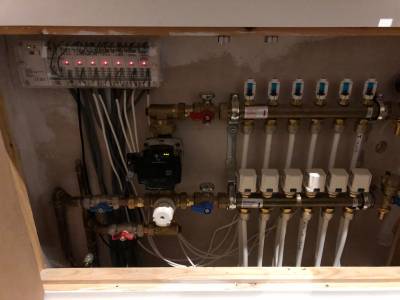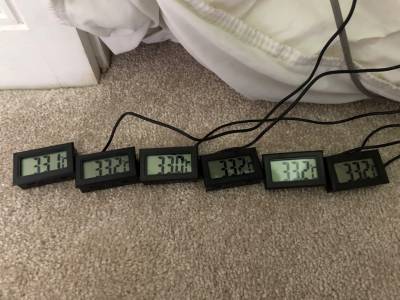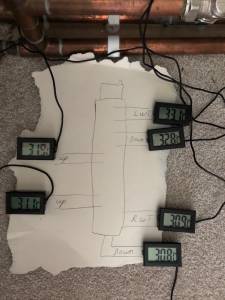Ecodan help with efficiency setup and design - removing manifold mixers, LLH and pumps
Hi all
After reading through others posts mainly all off "Ecodan. How to run this efficiently with zero understanding" I have decided I need to finally do something about my install.
background
back in 2021 we completely renovated the house new insulation was installed a MVHR full UFH upstairs and downstairs and new 8.5 KW Ecodan heat pump with 210l pre plumbed cylinder.
winter 2021 was expensive as weather compensation wasn't set up and every room (even open plan areas were zoned)
2022 was better as I learned more about weather compensation and combined all the downstairs open plan to one stat
this year has been about the same but it is in no way efficient.
The problem
The house is 3 bed (about 120 m2) and has 5 circulation pumps !! 🤡 the system is also controlled by 7 3rd party thermostats and the pre plumbed cylinder has a low loss header.
with weather compensation the circulation pumps never turn off even with the heatpump idling for hours and because we have so many I feel its costing a lot (using the energy monitor I think about 300w instant or 7KWh a day 😢
I have bought some amazon thermometers that I have installed on the low loss heater and noticed that the upstairs is receiving cooler water and had no real DT
The plan
After reading "How to correctly install heat pumps so that they work properly and efficiently" I think my ideal solution would be remove the manifold mixers and pumps, remove the circulation pumps, remove the low loss header, upgrade the one remaining pump that currently does the heat pump to low loss header so this can included all the UFH, I don't know if this is possible?
sorry if this post is a bit scattered I have tried to include as much information as I can I seem to have a lot of problems all going on at the same time I also think the heat pump maybe a bit oversized but that's its own problem. i've included some pictures bellow.
I am open to any ideas or knowledge you might have
Thanks for all your help
Rich
cylinder and low loss header
low loss header
manifold
manual showing cylinder
testing cheap amazon thermometers
example of normal running and +4 on the controller
I have sketched out my thought process to try and explain things easier. The hot water cylinder has a pre plumbed plate heat exchanger that I have tried to show.
The idea I think could work however I am not sure if one pump is powerful enough?
I also forgot to include the top setup has a bypass on both the upstairs and downstairs.
Thanks
I suppose the starting point would be to check the heat loss calculation for your home against the required Leaving Water Temperature (LWT) needed to meet this heat demand.
Since you have full UFH throughout your home I cannot, in principle, see any reason why you cannot remove the UFH mixing pumps and re-pipe the system as you propose.
You would probably need to check the specification of the main water pump to ensure that it can provide the required flowrate, with the head and size of pipework within your system.
You could probably keep the thermostats, but set them above desired room temperature to act as an over-temperature restriction.
You may also be able to keep the bypass valves provided that they do not bypass unless necessary.
Thanks for the reply
unfortunately all my knowledge has come along after install so I never asked or saw any heat loss calculations 🙄
the best I have is the MCS certificate that states 45c flow temperatures and 3.79 scop (I wish)
annual space heating 20,700 and water at 3,596
the EPC that was preformed after was 9,644 KWh heating and 2,954KWh water
with the weather outside colder now 0c the hes pump is reporting Lwt of 33c and the house is sat at 21c
The stats are currently set at 23 as temperature limiters that don’t ever get reached,
I’m not sure how I could guess the amount of pipework? again I did not ask enough questions at the time and relied on them being knowledgable so didn’t see the underfloor plan
Posted by: @richThanks for the reply
unfortunately all my knowledge has come along after install so I never asked or saw any heat loss calculations 🙄
the best I have is the MCS certificate that states 45c flow temperatures and 3.79 scop (I wish)
annual space heating 20,700 and water at 3,596
the EPC that was preformed after was 9,644 KWh heating and 2,954KWh water
with the weather outside colder now 0c the hes pump is reporting Lwt of 33c and the house is sat at 21c
The stats are currently set at 23 as temperature limiters that don’t ever get reached,
I’m not sure how I could guess the amount of pipework? again I did not ask enough questions at the time and relied on them being knowledgable so didn’t see the underfloor plan
If my understanding is correct, all this information should have been provided in a handover pack along with adequate training. If you did not receive a pack then I would suggest that you contact your installer and request one.
Thanks I did not receive a pack so will contact again, I don’t have very high hopes as the company who did all the plumbing had a MCS certified person “inspect” and commission the system. I was with him during the commissioning as got a 2 minute lesson on the controller and told if you have problems he could come back and do advanced things like alter the weather compensation curve.
I have tried to contact the company last year I think and the response I got was that the MCS certified person had become extremely hard to reach even for them and was not really responding,
unfortunately it has been a lesson learned in doing more research before starting.
This is why I want to fix the system myself if possible unfortunately the whole thing has left me with little trust of the next person coming and fixing it correctly
No problem if you don't have all the details, but someone should have carried out heat loss calculations to be able to adequately design the system.
The fact that your system is operating with a LWT of 33C at an Outside Air Temperature (OAT) of 0C, would seem to indicate that you don't have any serious problems. What is your concern?
Yeah I hope some calculations were done I think the company just sent all the plans to Mitsubishi and they suggested this if I’m completely honest.
The system seems to do well when it’s cold outside and struggle more with warmer conditions,
my concern is due to the system running 24/7 in weather compensation the 5 pumps run constantly. I tried turning the temperature down so the heatpump turned off and measured the power before stopping the pumps and powering down and this difference was 300w or 7.2kwh per day I know it will take energy to move the water around the system but 1,500kwh in 6 months heating seems a lot ?
Posted by: @richYeah I hope some calculations were done I think the company just sent all the plans to Mitsubishi and they suggested this if I’m completely honest.
The system seems to do well when it’s cold outside and struggle more with warmer conditions,
my concern is due to the system running 24/7 in weather compensation the 5 pumps run constantly. I tried turning the temperature down so the heatpump turned off and measured the power before stopping the pumps and powering down and this difference was 300w or 7.2kwh per day I know it will take energy to move the water around the system but 1,500kwh in 6 months heating seems a lot ?
You are probably correct.
You should certainly be able to remove the mixing valves and UFH pumps, which would normally be required if you have a mix of UFH and radiators or a higher temperature boiler.
I would suggest that you ask your installer for details of the UFH pipework and capacity, since you may need to ensure the system has the minimum volume required by your heat pump.
As a test, you could try bypassing the Low Loss Header (LLH), remove the two circuit pumps after the LLH and put pipework in their place, then see if the main water pump is able to cope.
@rich seems to me like you should be able to do what you have drawn, yes the LLH is ruining your COP based on those temps you've measured.
the fact you are UFH throughout is great, means the temperature down-mixing valves not needed. your pump electrical usage to move the water is indeed excessive. don't stress too much about not knowing the heat loss or head loss, you can take an empirical approach. If after re-piping so that its all done by one of your existing pumps, that one pump isn't quite enough (it'll be obvious, some areas won't get flow) its trivial to buy 1 larger pump. you'll still gain a lot on electrical usage. worst case you may have to tolerate some part of the house not being warm enough until you're able to get and fit a larger pump. although, looking at your pictures one of the pumps mounted on the cylinder looks "bigger" so you might be ok - is that the one driving the primary from the heat pump outdoor unit? what type pump is it?
My octopus signup link https://share.octopus.energy/ebony-deer-230
210m2 house, Samsung 16kw Gen6 ASHP Self installed: Single circulation loop , PWM modulating pump.
My public ASHP stats: https://heatpumpmonitor.org/system/view?id=45
11.9kWp of PV
41kWh of Battery storage (3x Powerwall 2)
2x BEVs
Thanks for all the advice, I have contacted the original installer and asked if they can send over any information they might still have.
You are correct the pump that circulates the heatpump is different its a UPM GEO 25-85 130 I couldn't find a great deal of information about it online but did manage to find this chart.
I think as you have said my best approach is to do the modifications and monitor the results I remember reading you can check the flow using the FTC and I am fairly sure I could restrict the upstairs flow more to push it around other circuits as this always has a very low DT
I cant seen to upload the screenshot at the moment but I found the chart here on page 38
@rich a UPM 25-85 130 is fairly beefy, it may well be enough to run the whole thing. I run a 210m2 house on a single UPM 25-95 130.
My octopus signup link https://share.octopus.energy/ebony-deer-230
210m2 house, Samsung 16kw Gen6 ASHP Self installed: Single circulation loop , PWM modulating pump.
My public ASHP stats: https://heatpumpmonitor.org/system/view?id=45
11.9kWp of PV
41kWh of Battery storage (3x Powerwall 2)
2x BEVs
-
Ecodan unable to hit legionella target temp - what's the consensus?
5 days ago
-
Mitsubishi Ecodan 11kw Defrosting Issue.
3 weeks ago
-
Have Consumers Been Lied to About the Efficiency of Heat Pumps Made in China?
5 months ago
-
Ecodan consuming 100kwh per day in new build!!!
6 months ago
-
Help with understanding my Mitsubishi Ecodan air source heat pump
9 months ago
- 26 Forums
- 2,378 Topics
- 53.9 K Posts
- 172 Online
- 6,060 Members
Join Us!
Worth Watching
Latest Posts
-
RE: Radiator sizing sanity check
No chance! Largely, hence my suggestion to do some...
By JamesPa , 9 hours ago
-
RE: Testing new controls/monitoring for Midea Clone ASHP
As it turns out this is correct! All I needed to do was...
By benson , 10 hours ago
-

Here is an update of the setback we operate on our syst...
By SUNandAIR , 12 hours ago
-
RE: Grant ASHP 17.5 kw. weather curve
@chinkoa Sorry there are two separate thoug...
By JamesPa , 13 hours ago
-
RE: Solar Power Output – Let’s Compare Generation Figures
@transparent As easy as putting sparklers in champag...
By Papahuhu , 13 hours ago
-
@f1p Looks good, and will likely be something I use whe...
By Sheriff Fatman , 16 hours ago
-
RE: Cascade 2x Grant Areona 10kw ASHP - Ongoing setup issues
Either complete Bow Locks or at best a marginal effect....
By JamesPa , 19 hours ago
-
Hi all I’m looking to get some insight on what others...
By Renewables345 , 19 hours ago
-

RE: The Great British Heat Pump Owner Persona Survey: Let's Build Our Archetype!
@mosibi, go on then, complete the survey. Let's get the...
By Mars , 19 hours ago
-
RE: Water Hammer After Heat Pump Install
@jaynieq I wish you luck with this one. I think the ma...
By JamesPa , 21 hours ago
-
RE: Optimum new build house design for Heat Pump
From first principles I would say: Definitel...
By JamesPa , 2 days ago
-

RE: Weather compensation- why you should use it
As good a place as any to drop this video:/p>
By Mars , 2 days ago
-
RE: Forum updates, announcements & issues
@transparent D'Oh - I did look before I posted but I mi...
By dr_dongle , 2 days ago
-
Compatibility with Samsung AE080RXYDEH
I am new to all this. We have a SamsungAE080RXYDEH that...
By John999 , 2 days ago
-
RE: New Fogstar 15.5kWh upright solution
@batpred Maybe you should buy your additional batter...
By Bash , 2 days ago
-

RE: Data Accuracy Problem: Daikin 8kW Heat Pump's Onecta App vs MMI Power Consumption
@nursethescreens Yes, comfort and happiness of the fami...
By Toodles , 2 days ago
-
RE: Connecting Growatt SPH5000 over wired ethernet rather than wireless
Thanks folks. I had tried googling an ethernet lab adap...
By z8lccda , 2 days ago
-
RE: Changing from 4-port buffer to volumizer
@toodles I'm not concerned that the behaviour is not no...
By Andy1618 , 2 days ago
-

-

RE: Setback savings - fact or fiction?
I agree, and I think there are two things in play here....
By cathodeRay , 3 days ago












